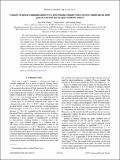Capacity of optical communications over a lossy bosonic channel with a receiver employing the most general coherent electro-optic feedback control
Author(s)
Chung, Hye Won; Guha, Saikat; Zheng, Lizhong
DownloadPhysRevA.96.012320.pdf (476.0Kb)
PUBLISHER_POLICY
Publisher Policy
Article is made available in accordance with the publisher's policy and may be subject to US copyright law. Please refer to the publisher's site for terms of use.
Terms of use
Metadata
Show full item recordAbstract
We study the problem of designing optical receivers to discriminate between multiple coherent states using coherent processing receivers—i.e., one that uses arbitrary coherent feedback control and quantum-noise-limited direct detection—which was shown by Dolinar to achieve the minimum error probability in discriminating any two coherent states. We first derive and reinterpret Dolinar's binary-hypothesis minimum-probability-of-error receiver as the one that optimizes the information efficiency at each time instant, based on recursive Bayesian updates within the receiver. Using this viewpoint, we propose a natural generalization of Dolinar's receiver design to discriminate M coherent states, each of which could now be a codeword, i.e., a sequence of N coherent states, each drawn from a modulation alphabet. We analyze the channel capacity of the pure-loss optical channel with a general coherent-processing receiver in the low-photon number regime and compare it with the capacity achievable with direct detection and the Holevo limit (achieving the latter would require a quantum joint-detection receiver). We show compelling evidence that despite the optimal performance of Dolinar's receiver for the binary coherent-state hypothesis test (either in error probability or mutual information), the asymptotic communication rate achievable by such a coherent-processing receiver is only as good as direct detection. This suggests that in the infinitely long codeword limit, all potential benefits of coherent processing at the receiver can be obtained by designing a good code and direct detection, with no feedback within the receiver.
Date issued
2017-07Department
Massachusetts Institute of Technology. Department of Electrical Engineering and Computer ScienceJournal
Physical Review A
Publisher
American Physical Society
Citation
Chung, Hye Won, Saikat Guha, and Lizhong Zheng. “Capacity of Optical Communications over a Lossy Bosonic Channel with a Receiver Employing the Most General Coherent Electro-Optic Feedback Control.” Physical Review A 96, no. 1 (July 17, 2017).
Version: Final published version
ISSN
2469-9926
2469-9934